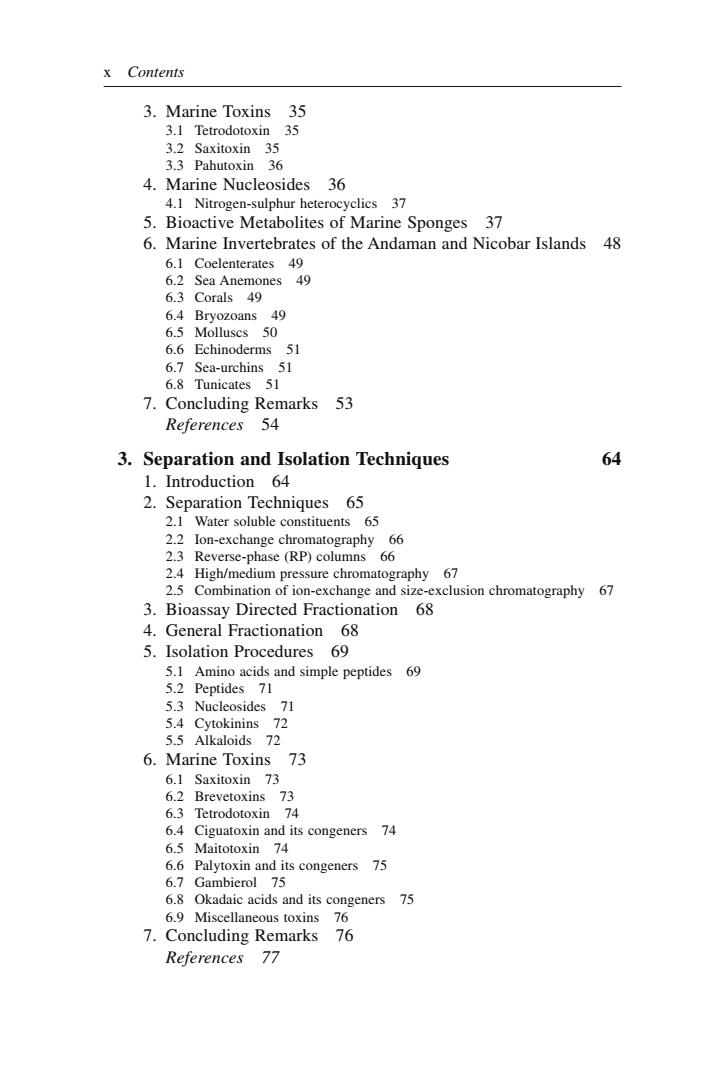正在加载图片...

x Contents 3.Marine Toxins 35 3.1 Tetrodotoxin 35 4.Marine Nucleosides 36 4.1 Nitrogen-sulphur heterocyclics 37 5.Bioactive Metabolites of Marine Sponges 37 6.Marine Invertebrates of the Andaman and Nicobar Islands 48 6.1 Coelenterates 49 rals 66 Echinod 7.Concluding Remarks 53 References 54 3.Separation and Isolation Techniques 64 1.Introduction 64 2.Separation Techniques 65 2.1 Water soluble constituents 65 2 on-exchange ch phy 67 2.5 Combination of ion-exchange and size exclusion chromatography 67 3.Bioassay Directed Fractionation 68 4.General Fractionation 68 5.Isolation Procedures 69 71 5.4 Cytokinins 72 5.5 Alkaloids 6.Marine Toxins 73 nd Is congeners 75 75 Oadaic acids and its 7.Concluding Remarks References 77 x Contents 3. Marine Toxins 35 3.1 Tetrodotoxin 35 3.2 Saxitoxin 35 3.3 Pahutoxin 36 4. Marine Nucleosides 36 4.1 Nitrogen-sulphur heterocyclics 37 5. Bioactive Metabolites of Marine Sponges 37 6. Marine Invertebrates of the Andaman and Nicobar Islands 48 6.1 Coelenterates 49 6.2 Sea Anemones 49 6.3 Corals 49 6.4 Bryozoans 49 6.5 Molluscs 50 6.6 Echinoderms 51 6.7 Sea-urchins 51 6.8 Tunicates 51 7. Concluding Remarks 53 References 54 3. Separation and Isolation Techniques 64 1. Introduction 64 2. Separation Techniques 65 2.1 Water soluble constituents 65 2.2 Ion-exchange chromatography 66 2.3 Reverse-phase (RP) columns 66 2.4 High/medium pressure chromatography 67 2.5 Combination of ion-exchange and size-exclusion chromatography 67 3. Bioassay Directed Fractionation 68 4. General Fractionation 68 5. Isolation Procedures 69 5.1 Amino acids and simple peptides 69 5.2 Peptides 71 5.3 Nucleosides 71 5.4 Cytokinins 72 5.5 Alkaloids 72 6. Marine Toxins 73 6.1 Saxitoxin 73 6.2 Brevetoxins 73 6.3 Tetrodotoxin 74 6.4 Ciguatoxin and its congeners 74 6.5 Maitotoxin 74 6.6 Palytoxin and its congeners 75 6.7 Gambierol 75 6.8 Okadaic acids and its congeners 75 6.9 Miscellaneous toxins 76 7. Concluding Remarks 76 References 77